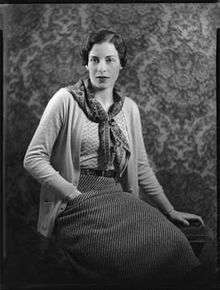Sheila Wingfield
| Sheila Wingfield | |
|---|---|
 | |
| Born |
23 May 1906 Hampshire, England |
| Died |
January 8, 1992 (aged 85) County Dublin, Ireland |
| Occupation | Writer, poet |
| Nationality | Irish |
| Genre | Imagist Movement |
Sheila Wingfield (née Sheila Claude Beddington; Viscountess Powerscourt; 23 May 1906 – 8 January 1992)[1] was an Irish poet.
Life and work
Lady Powerscourt was born in Hampshire and attended the Roedean School.[2] She attended art school in Paris.[3] She was the daughter of Major Claude Beddington and Frances Ethel (née Homan-Mulock). Ethel was the daughter of a Protestant family from Co. Offaly, whose homes included the Bellair and Ballycumber estates, where Lady Powerscourt spent most of her childhood summer holidays. Her mother was also the author of All That I Have Met.[4] Lady Powerscourt later inherited the Bellair estate from her aunt. Her mother's uncle was Alfred Austin, Poet Laureate.[5]
Her father was from a Jewish family who had changed the surname from Moses. They had earned their wealth in the tobacco trade. Her parents did not approve of her interest in writing so she hid her interest.[2] Her father went so far as to forbid her to read.[3] She also hid her Jewish background from those around her, again at her father's insistence. Her cousins included the Jewish literary figures Violet Schiff and Ada Leverson, and her grandfather was born Alfred Henry Moses.[6]
In 1932 she married Hon. Mervyn Patrick Wingfield (1905–1973), later the 9th Viscount Powerscourt in Jerusalem. They had three children, a daughter and two sons: Grania Langrishe, Mervyn and Guy Wingfield.
Her poems were first published in The Dublin Magazine of 1937.[7] Although initially supportive her husband later requested her not to be involved in the literary circle in Ireland.[3] During her life she produced eight collections of verse and three memoirs of Irish life, although she is not well known in Ireland. This is despite the admiration of Elizabeth Bowen, W. B. Yeats, John Betjeman, T. S. Eliot and James Stephens.[8][9] However, she and Yeats had a falling out when she used his praise from a private letter on the cover of her first publication. She suffered her first breakdown during the production of that publication. Lady Powerscourt wanted to be a respected poet. She suffered from addictions to alcohol, morphine and cocaine. Her drug use had started during her seasons in London.[10][11]
The Second World War had a huge impact on the family. Viscount Powerscourt served in the war and was captured by the Germans in Italy. When he came home his health had been compromised and he suffered from shell shock. Lady Powerscourt had taken the family to Bermuda. They returned home when he did. Her best work was written in response to the war, Beat Drum, Beat Heart (1946). Her husband came into his inheritance of the Powerscourt Estate in 1947.[3]
She became the leader of Irish Girl Guides and helped catalogue Chester Beatty Library. Her marriage never recovered from the impact of the war. however. In 1963 she left her husband and as a result of the financial impact the family sold Powerscourt. Lady Powerscourt lived after that in hotels in Bermuda, London, Dublin and Switzerland. She finally died in a home near Dublin.[3]
In the 1950s, Lady Powerscourt won the Poetry Society Book Choice.[3]
The Sheila Wingfield Papers are being kept in the National Library of Ireland and Houghton Library, Harvard University.[12]
Bibliography
Collections
- Poems (London: Cresset Press, 1938)
- Beat Drum, Beat Heart (London: Cresset Press, 1946)
- A Cloud Across the Sun (London: Cresset Press, 1949)
- A Kite’s Dinner: Poems 1938-54 (London: Cresset Press, 1954)
- The Leaves Darken (London: Weidenfeld & Nicolson, 1964)
- Admissions: Poems 1974-1977 (Dublin: Dolmen Press; London: John Calder, 1977)
- Her Storms: Selected Poems 1938-1977, with a preface by G. S. Fraser (Dublin: Dolmen Press, 1977)
- Collected Poems: 1938-1983, preface by G. S. Fraser (London: Enitharmon Press; NY: Hill & Wang, 1983)
- Ladder to the Loft (London: Cygnet Press, 1987)
Autobiography and memoir
- Real People, with a foreword by John Betjeman (London: Cresset Press 1952)
- Sun Too Fast (London: Bles [1973], 1974)
Further reading
- Penny Perrick, Something to Hide: The Life of Sheila Wingfield, Viscountess Powerscourt, 2007, ISBN 978 1 84351 093 2
- Wingfield Family at Powerscourt
- Alexander G. Gonzalez, Irish Women Writers: An A-to-Z Guide, Greenwood Publishing Group, 2006, 348 pages
- Lucy Collins, Sheila Wingfield, 2013, ISBN 9781907593666
- Alex Davis, "'Wilds to Alter, Forms to Build': The Writings of Sheila Wingfield",Irish University Review, Vol. 31, No. 2 (Autumn – Winter, 2001), pp. 334-352; published by: Edinburgh University Press
- Irish Literature: Feminist Perspectives, Patricia Coughlan, Tina O'Toole, Peter Lang, 2008 - 298 pages
References
- ↑ "Contemporary Authors Online". Biography in Context. Gale. 2003. Retrieved 2 March 2016.
- 1 2 "Oxford Biography".
- 1 2 3 4 5 6 Anne Roper (2011). "Journal of Enniskerry and Powerscourt Local History" (PDF). 1.
- ↑ Mrs. Claude Beddington (1929). All That I Have met. Cassell.
- ↑ "Irish Berry Genealogy".
- ↑ Anne Sebba. "Book Reviews: Something to Hide: The Life of Sheila Wingfield".
- ↑ "SHEILA WINGFIELD PAPERS in the National Library of Ireland" (PDF).
- ↑ "Hiding in Plain Sight".
- ↑ "Reference details for the RTE show:Hiding in Plain Sight".
- ↑ "Sheila Wingfield (1906-1992)".
- ↑ "The forgotten poet". Irish Independent. 17 March 2007.
- ↑ "Harvard University".